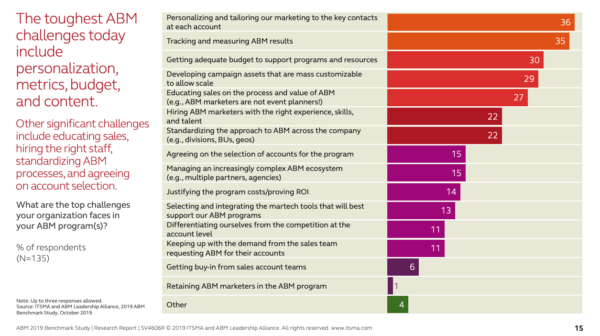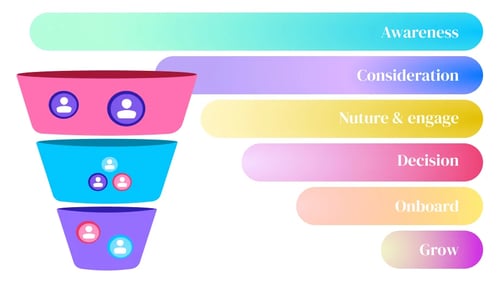
Account-based marketing (ABM) is an increasingly popular strategy in the B2B industry. Known for closing more qualified leads, ABM yields a higher ROI; 71% of ABM marketers cited a higher return than traditional marketing initiatives. ABM budgets have increased 21% in the last year, according to ITSMA, making this a much-watched strategy for any B2B company.
Account-based marketing comes with its challenges. LinkedIn's study found that B2B marketers struggle to find reliable data, create personalized content at scale, prove effectiveness on the sales pipeline, and develop content for the buyer group.

ITSMA's findings illustrate similar challenges, with 36% of respondents citing personalizing marketing as an obstacle, followed by tracking ABM results (35%), developing campaign assets at scale (29%), and educating sales on the process and value of ABM (27%).

Tackling these challenges takes time. Transitioning to account-based marketing is not a quick process and requires patience from teams. Two of the biggest challenges are getting the sales team on board with this new way of work and fostering a collaborative environment between the sales and marketing teams.
Once teams understand ABM's value, they can work together to create personalized content at scale and test different marketing tactics.
The challenge of educating the sales team on ABM and proving ABM's impact on the pipeline can be achieved by getting the sales team on board. This is no easy task, but effective multichannel ABM strategies require sales participation, making it the first step to developing a successful ABM strategy internally.
To address this challenge, companies must address sales team concerns and provide concrete data demonstrating ABM's value and effectiveness. Transitioning to a focus on specific accounts can make the sales team feel they are neglecting other potential leads. Therefore, it is essential for sales teams to shift their perspective on the sales process and abandon the notion of working in isolation.
Connecting sales and marketing teams earn better results. Many companies struggle with this, as ITSMA found that only 16% of ABM teams are satisfied with the degree of the ongoing collaboration between sales and marketing.
The most effective ABM programs strongly integrate the two groups, making this a necessary strategy. Sales and marketing alignment does not happen overnight, but teams can automate this process through CRM tools such as HubSpot and by creating a collaborative environment. Again, like ABM itself, sales and marketing alignment takes patience and a high level of communication.
These two teams working together solve the challenge of account-based marketers not having access to useful data. When the sales team works in a silo, marketers are left wondering how effective their campaigns are, as they do not have access to this data. Putting these two teams together allows for better data gathering and analysis across the company.
ABM content marketing takes a different approach. Account-based marketers start by segmenting along the sales funnel. The top, middle, and bottom-of-the-funnel prospects are all at different points in the buyer's journey so they will need different types of content.

ABM content doesn't stop there; instead, it segments those lists again by industry, account, type of lead, or topic. A personalized piece of content could be, for example, a short eBook discussing the pain points for IoT marketers (this targets the top-of-the-funnel and a specific industry).
Taking on this challenge can begin with auditing the current content. Most marketers have a robust library of written resources that can be categorized and used for a particular segment. While categorizing content takes time, personalized content is a driving force behind ABM's success.
Becoming ABM-driven takes time and numerous tests. Teams cannot expect to hit it out of the park right away. Instead, companies should learn how to iterate and test an account-based marketing campaign.
Different testing methods are crucial to success, including audience, platform, messaging, creating, and budget. Since ABM focuses on a multichannel experience, the testing and optimization process takes time.
Sources
ITSMA, Moving to ABM Maturity: 2019 ABM Benchmark Study, December 2019.
LinkedIn, Introducing the B2B Jumpstart to Account-Based Marketing Guide, October 17, 2019.
by Jonathan Franchell, CEO of Ironpaper - For more tips and hacks: Need to remove a new line after h1 tags? Both web designers and SEO practitioners need to employ headline tags: H1, H2, H3 in several ways to improve web page structure and tag...

The Crowded Arena of the IT Marketplace Updated December 2024 The Information Technology (IT) landscape is experiencing rapid growth and intensifying competition. IT spending is projected to reach nearly 5.1 trillion U.S. dollars in 2024, a...

Updated December, 2024 The field of digital marketing is evolving rapidly in response to new technology and changing buyer expectations. To help career-minded marketers, we’ve rounded up the top 10 skills needed to succeed in the field. These are...

The marketing industry is transforming significantly due to generative AI and increasing market complexity. Gartner's prediction of a 25% decline in traditional search traffic suggests that the era of search engines is dying. AI tools, particularly...
